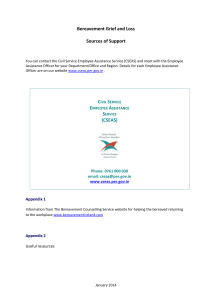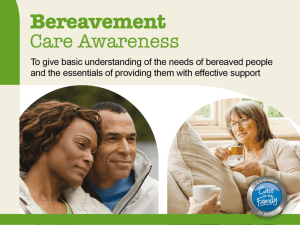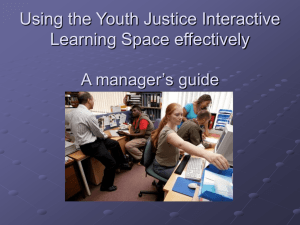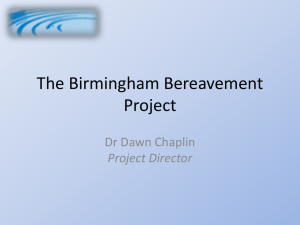matrix - Childhood Bereavement Network
advertisement
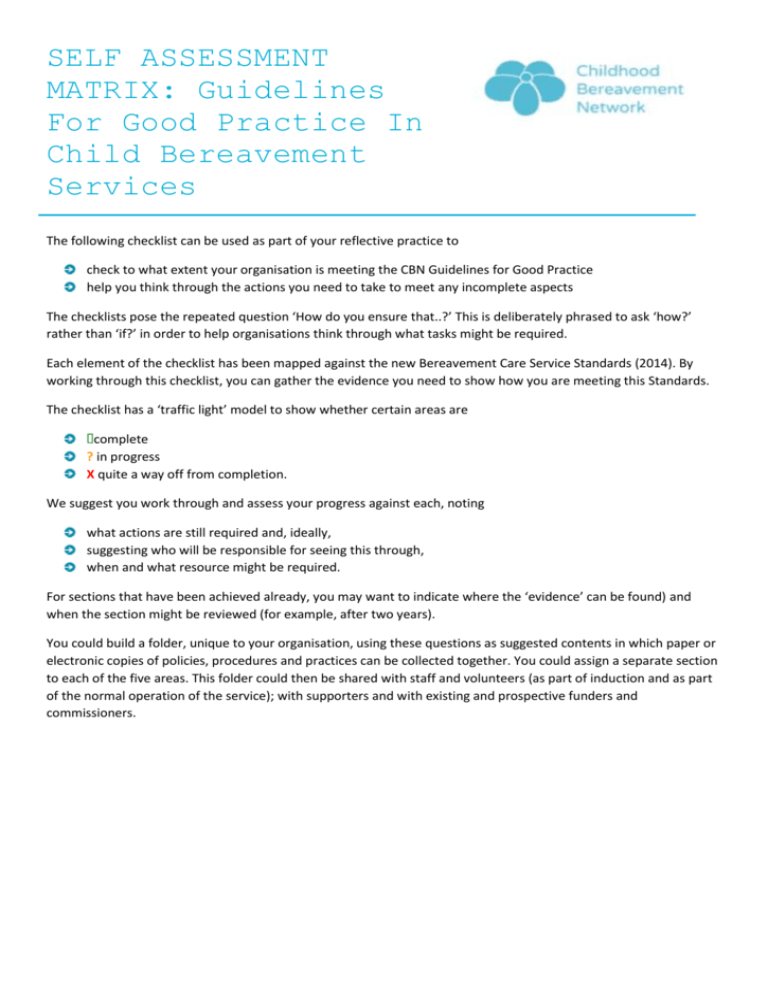
SELF ASSESSMENT MATRIX: Guidelines For Good Practice In Child Bereavement Services The following checklist can be used as part of your reflective practice to check to what extent your organisation is meeting the CBN Guidelines for Good Practice help you think through the actions you need to take to meet any incomplete aspects The checklists pose the repeated question ‘How do you ensure that..?’ This is deliberately phrased to ask ‘how?’ rather than ‘if?’ in order to help organisations think through what tasks might be required. Each element of the checklist has been mapped against the new Bereavement Care Service Standards (2014). By working through this checklist, you can gather the evidence you need to show how you are meeting this Standards. The checklist has a ‘traffic light’ model to show whether certain areas are complete ? in progress X quite a way off from completion. We suggest you work through and assess your progress against each, noting what actions are still required and, ideally, suggesting who will be responsible for seeing this through, when and what resource might be required. For sections that have been achieved already, you may want to indicate where the ‘evidence’ can be found) and when the section might be reviewed (for example, after two years). You could build a folder, unique to your organisation, using these questions as suggested contents in which paper or electronic copies of policies, procedures and practices can be collected together. You could assign a separate section to each of the five areas. This folder could then be shared with staff and volunteers (as part of induction and as part of the normal operation of the service); with supporters and with existing and prospective funders and commissioners. SELF-ASSESSMENT MATRIX: Guidelines for good practice in childhood bereavement services SAFE PRACTICE How do you ensure that: ✔ Evidence? Rev. date ? X Action required to complete Links to BCSS standard You consider the safety implications for service users and staff across the whole range of your work, for example, individual and group work, transport by volunteers, home visits and email support? Fundamental principle: safety There is a documented policy to ensure the overall safety of children using your services? 6.3 Service provides appropriate ratios of staff/volunteers, especially in relation to vulnerable and young people Fundamental principle: safety The policy incorporates a set procedure for the recruitment of paid staff and volunteers? Fundamental principle: safety All paid and voluntary staff receive training and supervision to ensure the overall safety of children using your service? 5.2 You work within the legislative framework and guidance? Fundamental principles There is a documented health and safety policy? Fundamental principles The service is properly insured? Fundamental principles There is a documented policy on confidentiality which is discussed and agreed with all your service users and staff? Fundamental principles: confidentiality FAIR PRACTICE How do you ensure that: ✔ Evidence? Rev. date There is a documented and proactive equal opportunities policy? ? X Action required to complete Links to BCSS standard 6. Resources are allocated so they are responsive to the differing needs of bereaved people Fundamental principles: respect; equality and diversity 2 SELF-ASSESSMENT MATRIX: Guidelines for good practice in childhood bereavement services You regularly review your service to identify and change discriminatory practice? Fundamental principles: equality and diversity You regularly undertake a needs assessment to review the accessibility and appropriateness of your service? 3. Bereaved people have their needs assessed in a manner appropriate to the service offered. This will be a continuous and ongoing two-way process that ensure both risk and resilience are identified. An appropriate plan is put in place to meet the identified needs of the bereaved person 3.1 Service staff/volunteers assess presenting situation and formulate plan of action 3.2 Service staff/volunteers undertake regular review of progress with the bereaved person with appropriate action taken 3.3 Service staff/volunteers use an assessment tool/framework and document accordingly You are able to respond to the needs of bereaved minority ethnic children, young people and their families? 6.2 Services provides access to communication support, eg interpreters You are able to respond to the needs of bereaved disabled children, young people and their families? 6.2 Service provides access to communication support, eg interpreters SUSTAINABLE PRACTICE How do you ensure that: ✔ Evidence? Rev. date You regularly undertake a needs assessment to review the appropriateness of your work or service? ? X Action required to complete Links to BCSS standard 1. Planning. Services have plans in place to address the needs of the client group/community they serve in the most appropriate way. 1.1 Service is planned in response to 3 SELF-ASSESSMENT MATRIX: Guidelines for good practice in childhood bereavement services identified needs 1.2 Service regularly reviews plans and evaluates activity to ensure development in line with emerging needs You liaise with users, key referral agencies, staff and other professionals working in your catchment area regarding any proposed service development? 2.3 Service works collaboratively with other statutory, community, commercial, voluntary or faith sector services to meet the diverse needs of bereaved people and maximise the potential for access to appropriate services. Your service is appropriately resourced, with good access to a safe space, room or premises and a budget to buy equipment? 6. Resources are allocated so they are responsive to the differing needs of bereaved people 6.1 Service provides designated areas and resources for providing bereavement care There is a business plan, including a funding strategy to ensure the sustainability of your service? 6 The principles embodied in the Childhood Bereavement Network Belief Statement are incorporated into your practice and the service you provide? Fundamental principles You have a statement of values and principles or mission statement with clear aims to define the remit of your service? 2. Awareness and Access. Services facilitate individual choice; are clear about what they can offer and to whom; know their limitations within defined boundaries and are able to signpost as appropriate. 2.1 Clear information is available in a user-friendly form about the service and what it can offer, and about other local or national bereavement services, agencies and support resources, for signposting or onward referral purposes There is a written definition of your service that clearly 2.1 4 SELF-ASSESSMENT MATRIX: Guidelines for good practice in childhood bereavement services sets out details of the information, guidance and support you offer and is regularly reviewed and updated? 2.2 Service offers immediate response, whether by telephone, online or in person, and sets out acceptable waiting times and operates within them This information is circulated to key referral agencies and potential users? 2.1 You publish and circulate an annual report to key referral agencies and users? 2.3 You liaise with other organisations to raise awareness of the needs of bereaved children, their families and other caregivers? 2.3 Service works collaboratively with other statutory, community, commercial, voluntary or faith sector services to meet the diverse needs of bereaved people and maximise the potential for access to appropriate services. You have a procedure to ensure effective liaison with other local, regional or national organisations offering similar services? 2.3 REFLECTIVE PRACTICE How do you ensure that: ✔ Evidence? Rev. date There is a documented policy to ensure that all staff are appropriately trained to work with bereaved children, their families and other caregivers? ? X Action required to complete Links to BCSS standard 5. Education and Training. All staff and volunteers who come into contact with bereaved people have the necessary skills and knowledge to provide support to these people. 5.1 Staff/volunteers receive general education about communication skills and bereavement awareness. 5.2 Staff/volunteers receive specialist training pertinent to their area of work. That training needs are regularly reviewed and all staff are offered regular opportunities to update their skills; 1.3 Service has awareness of/participates in relevant research initiatives to ensure support constitutes evidence-based 5 SELF-ASSESSMENT MATRIX: Guidelines for good practice in childhood bereavement services and there is a training budget? practice. 5.3 Staff/volunteers receive opportunities to access externally accredited training and development opportunities t ensure continued good practice. There is a documented policy on supervision; all staff are appropriately supervised and consulted on a regular basis about their supervision needs; and there is a budget for supervision? 4. Support and supervision. Services provide access to support and supervision to ensure safe working practice and afford staff and volunteers to recognise the impact of this work on them 4.1 Service staff/volunteers have ready access to timely ad hoc support 4.2 Staff/volunteers have access to and attend regular structured support activities 4.3 Service staff/volunteers have access to regular supervision as a requirement of continued practice You have procedures to enable you to monitor, evaluate and review the services you provide on a regular basis? 7. Monitoring and evaluation. Services continually review the support offered to ensure they are meeting the needs of bereaved people and to inform developments in the service 7.1 Service collects and analyses data, including service user feedback and complaints. Such data is used to improve the quality of the service offered. 7.2 Service monitors and regularly evaluates performance against the minimum standards and documents accordingly. Such documentation is made available on request to the public. Such data is used to improve the quality of the 6 SELF-ASSESSMENT MATRIX: Guidelines for good practice in childhood bereavement services service offered. You encourage feedback on your service from children, young people and their families, staff, key referral agencies and professionals? 7.1 There is a documented and accessible complaints procedure for children, young people, their families, key referral agencies, staff and the public? 7.1 DEVELOPING POLICIES AND PROCEDURES How do you ensure that: ✔ Evidence? Rev. date ? X Action required to complete Links to BCSS standard You have enough resources to develop, monitor and review policies? Fundamental principles You have a regular, rolling programme to review policies and ensure they comply with legal requirements? Fundamental principles You involve staff and service users in the process? Fundamental principles A named staff member or trustee takes responsibility for the process? Fundamental principles All employees and volunteers are introduced to the policies as part of their induction? Fundamental principles Ongoing training is provided to help staff develop skills and confidence in using the policies? 5 The policies are easy to find, use and monitor? Fundamental principles The policies cover all aspects of service delivery including face-to-face individual and group work, telephone and Fundamental principles 5. Education and Training. All staff and volunteers who come into contact with bereaved people have the necessary skills and knowledge to provide support to these people 7 SELF-ASSESSMENT MATRIX: Guidelines for good practice in childhood bereavement services email support and web-based activity? 8
